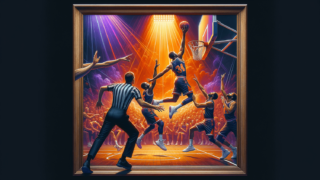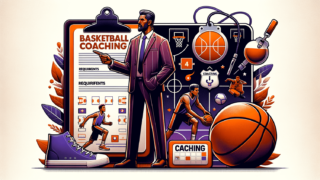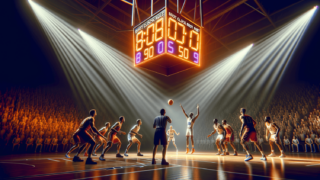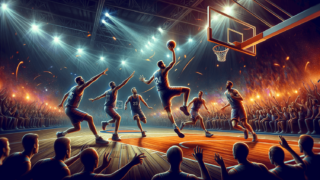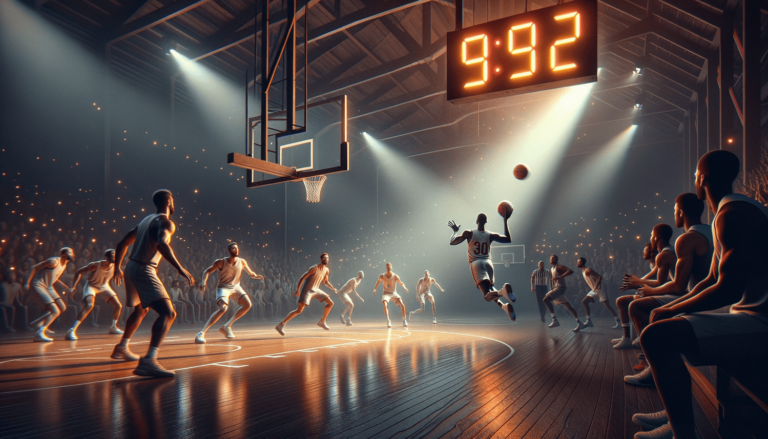
Five-Second Back-to-the-Basket Rule in Basketball
Written by: Basketball Universe
Last updated:

Calling all hoops enthusiasts! Are you ready to swish those nets with knowledge about one of the lesser-known rules in basketball? In this blog post, we’ll be delving into the intricacies of the Five-Second Back-to-the-Basket Rule. As the clock ticks, you’ll discover the ins and outs of this rule’s origin, its impact on the game, and how to apply it to your play like a pro. So, buckle up and let’s embark on this whistle-stop tour of the Five-Second Back-to-the-Basket Rule in Basketball!
Five-Second Back-to-the-Basket Rule in Basketball
The Five-Second Back-to-the-Basket Rule, also known as the “five-second post play” or “five-second closely guarded” rule, in basketball refers to a regulation where an offensive player in the frontcourt, while closely guarded by a defender, cannot hold or dribble the ball with their back to the basket for more than five consecutive seconds. Violating this rule results in a turnover, providing the opposing team with possession of the ball. The rule aims to encourage fluid movement and limit stagnation, making the game more engaging and challenging for both players and spectators.
History of the Five-Second Back-to-the-Basket Rule
Before diving into the nitty-gritty of the five-second back-to-the-basket rule, let’s take a quick journey down memory lane to explore its origin. The National Basketball Association (NBA) introduced this rule during the 1981-82 season as a response to the growing influence of dominant post-players like Kareem Abdul-Jabbar. These players leveraged their size advantage to hold the ball for extended periods, slowing down the game and hindering its entertainment value. With this rule in place, the camaraderie of teamwork was promoted and the game’s fast-paced nature was preserved, ensuring the excitement we love in modern basketball!
Understanding the Rule’s Conditions
Now that we’ve laid down the groundwork, it’s time to delve deeper into the specifics of the Five-Second Back-to-the-Basket Rule. This rule has certain conditions that need to be satisfied for its enforcement:
1. Closely Guarded Player
For the rule to apply, the offensive player must be closely guarded, i.e., a defender should be actively guarding them with an intent to impede offensive progress within six feet. If this distance is exceeded or the defender’s intent is lacking, the five-second count is discontinued.
2. Frontcourt Positioning
The rule applies only when the offensive player with the ball is within his team’s frontcourt, meaning the half of the court closest to the opponent’s basket. If the player is in the backcourt, the countdown isn’t activated.
3. Ball Handling
Finally, the rule comes into play when the offensive player is either dribbling or holding the ball with their back to the basket. Should the player pivot or face the basket, the clock will reset, restarting the count only if they turn their back to the basket once again while remaining closely guarded.
Recognizing Common Mistakes
While the five-second back-to-the-basket rule may seem simple at first glance, beginners and seasoned players alike can easily make mistakes while attempting to follow it. Recognizing these frequent errors can help you adjust your in-game strategies for a smoother and more efficient play.
1. More than Just Post Play
Contrary to popular belief, this rule isn’t exclusive to post play or players in the paint. It applies to any offensive player within their frontcourt (regardless of position) who meets the other conditions.
2. Free Throws and Inbounding
During free throws and inbounding plays, the five-second back-to-the-basket rule is suspended. These instances include inbound passes, throw-ins after a made basket, and free throws. In such cases, other basketball rules dictate the duration players can hold or touch the ball.
3. Confusion with Other Five-Second Rules
Basketball features various five-second rules, such as closely guarded violations in the high school or NCAA games, where an offensive player with no dribble must pass or shoot the ball within five seconds. Players often mix up these two distinct regulations, so it’s essential to remember that the back-to-the-basket rule applies only in specific scenarios dictated by the conditions discussed earlier.
Strategies for Offense and Defense
Effective application of the five-second back-to-the-basket rule can give both offensive and defensive players a strategic advantage. With a strong understanding of the rule and quick thinking, you can create more scoring opportunities or stop your opponents’ attacks.
Offensive Strategy
As an offensive player, your primary goal should be to avoid violating the rule while retaining possession for your team. Here are a few tips to help you accomplish this:
- Limit Dribbling: Dribble only when necessary to create openings for passes or shots, and always keep an eye on an engaged defender.
- Preserve Pivoting: Try not to use your pivot prematurely, as it can limit your options in passing, shooting, or driving to the basket. A well-timed pivot can reset the count or create space for a play.
- Jab and Rip Through: Master the art of jabs and rip-through moves to maintain an aggressive stance, create separation from your defender, and face the basket confidently.
- Quick Passes: Keep the ball moving with rapid, precise passes to confound your defender and avoid the high-risk zones near the sidelines and baseline.
Defensive Strategy
From a defensive standpoint, forcing a five-second back-to-the-basket violation can be a significant victory. To achieve this, consider the following tactics:
- Containment: Stay within the six-feet proximity to your adversary, maintaining an active guarding stance at all times to ensure the count continues.
- Anticipate Movement: Predict patterns in your opponent’s movements, studying their habits to foresee and counter their strategies effectively.
- Prompt Help: Teamwork is crucial in forcing a violation. Swift help from fellow defenders can prevent the offensive player from easily pivoting or driving, allowing the count to wear on.
- Pressure Communication: Strong communication with teammates and awareness of the official count can put additional pressure on the offensive player, prompting them to make rash decisions, ultimately leading to a turnover.
With the tips above, you’re well on your way to leveraging the power of the Five-Second Back-to-the-Basket Rule effectively, mastering its implications on your offensive and defensive play. By understanding the intricate nature of basketball rules, you can elevate your game and create a more dynamic and thrilling experience for everyone involved!
Impact of the Five-Second Back-to-the-Basket Rule on the Game
Beyond individual players’ strategies, the Five-Second Back-to-the-Basket Rule has had a significant effect on the game of basketball as a whole. The introduction of this rule has contributed to the evolution of the on-court dynamics, shaping the way basketball is played today.
1. Increased Tempo and Fluidity
One of the most noticeable impacts of this rule is the increased game tempo and fluidity. The five-second limit discourages players from stalling or dominating the ball, fostering a more vibrant playing style that resonates with fans and appeals to the audience.
2. Emphasis on Teamwork
Due to the restrictions placed on individual ball possession, the five-second back-to-the-basket rule has pushed players to rely more heavily on their teammates. Quick passes and effective communication have become paramount to offensive success, reinforcing the importance of teamwork in basketball.
3. Rise in Perimeter Play
In the modern era of basketball, we are witnessing the growth of perimeter play as teams increasingly focus on three-point shooting and driving from the outside. The five-second back-to-the-basket rule has indirectly necessitated the integration of a diverse set of skills and playing strategies, bringing forth an era of versatile players.
Notable Exceptions and Adaptations to the Rule
While the NBA’s five-second back-to-the-basket rule is relatively standard across various leagues, there are a few notable exceptions and adaptations worth mentioning:
1. FIBA and Other International Competitions
In FIBA and other international competitions, this rule does not exist. Instead, they only enforce the five-second closely guarded rule for players holding the ball without dribbling, irrespective of the player’s orientation to the basket.
2. NCAA and High School Basketball
At the collegiate level, the NCAA has imposed distinct shot clock limitations, which somewhat compensate for the absence of the NBA-style five-second back-to-the-basket rule. High school basketball generally follows the NFHS’ five-second closely guarded rule, similar to FIBA, imposing a five-second count on players holding or dribbling the ball while closely defended, regardless of whether their back is to the basket.
By acknowledging the rule’s impact on the game, appreciating its minor differences across various leagues and platforms, and understanding the objectives it seeks to accomplish, you’ll be able to apply the Five-Second Back-to-the-Basket Rule effectively on the court, irrespective of the competition you’re participating in.
FAQs About the Five-Second Back-to-the-Basket Rule
To ensure that you understand every facet of this compelling rule, we’ve compiled a list of frequently asked questions and answers that delve even deeper into various aspects of the Five-Second Back-to-the-Basket Rule in basketball. From different game scenarios to the rule’s influence across leagues, we’ve got you covered!
1. Does the five-second back-to-the-basket rule apply to defensive players?
No, the Five-Second Back-to-the-Basket Rule only applies to offensive players who meet the specific conditions outlined within the rule.
2. What happens if the count reaches four seconds and the player passes the ball?
If the offensive player passes the ball before the five-second count is completed, the play continues without any violations, and the count resets for the next applicable situation.
3. Can a shorter offensive player exploit the rule to their advantage?
Yes, shorter offensive players can use the rule to their advantage by drawing fouls, using speed, and agility to pass or shoot before reaching the five-second limit. Agility and quick decision-making can help shorter players effectively counter tall defenders.
4. Does a player receive a personal foul for committing a five-second back-to-the-basket violation?
No, a five-second back-to-the-basket violation does not result in a personal foul against the player. It simply causes a turnover, and the opposing team gains possession of the ball.
5. Is the rule included in street basketball or pick-up games?
While the five-second back-to-the-basket rule is not formally included in street basketball or pick-up games, players may still enforce it by mutual agreement as part of upholding sportsmanship and maintaining game flow.
6. How does the rule affect post players and their value in modern basketball?
Post players have adapted to the rule by honing a versatile skillset, incorporating better passing, footwork, and various moves to maintain an aggressive stance and avoid violations. The rule has contributed to the development of well-rounded and multi-dimensional players.
7. Does the shot clock reset if there is a five-second back-to-the-basket violation?
When a five-second back-to-the-basket violation occurs, the shot clock does not reset. The opposing team gains possession of the ball, and the game continues with the shot clock at its current time.
8. Can a player pivot to face the basket during the five-second count?
Yes, a player can pivot to face the basket during the five-second count. If the player faces the basket, the count is reset, and no violation is called.
9. How does the five-second back-to-the-basket rule differ from the three-second rule?
While the five-second back-to-the-basket rule concerns an offensive player dribbling or holding the ball with their back to the basket, the three-second rule pertains to the amount of time an offensive player can spend within the free-throw lane (paint) without actively attempting a shot. The two rules serve different purposes and address distinct aspects of gameplay.
10. In the NBA, does the five-second back-to-the-basket rule apply during the playoffs?
Yes, the five-second back-to-the-basket rule is in effect during both the NBA regular season and playoff games, maintaining consistent gameplay and enforcement of the rule.
Featured Posts
- No pillar pages found.
